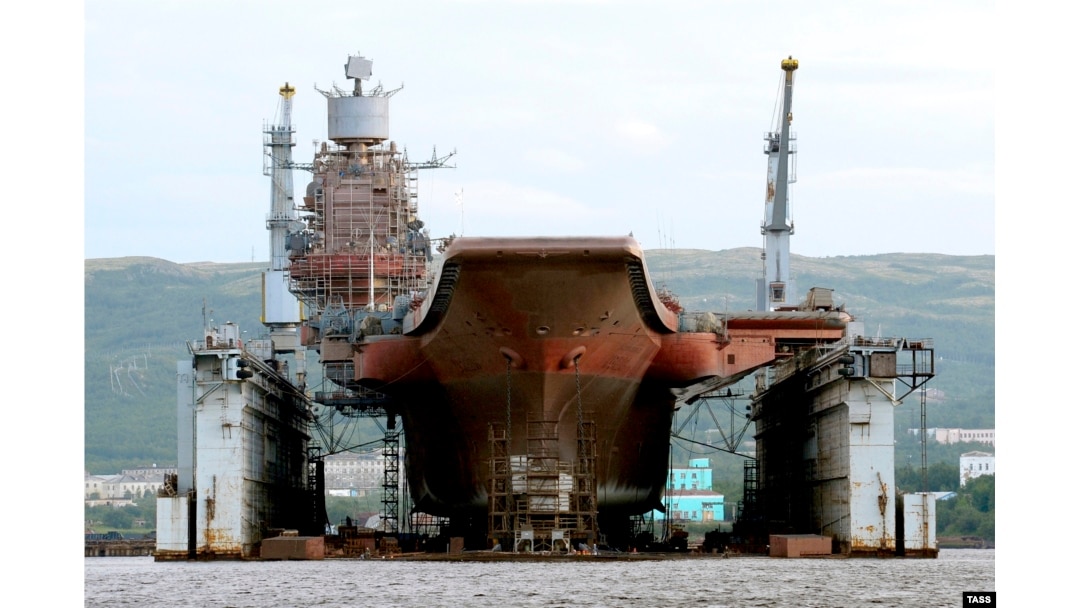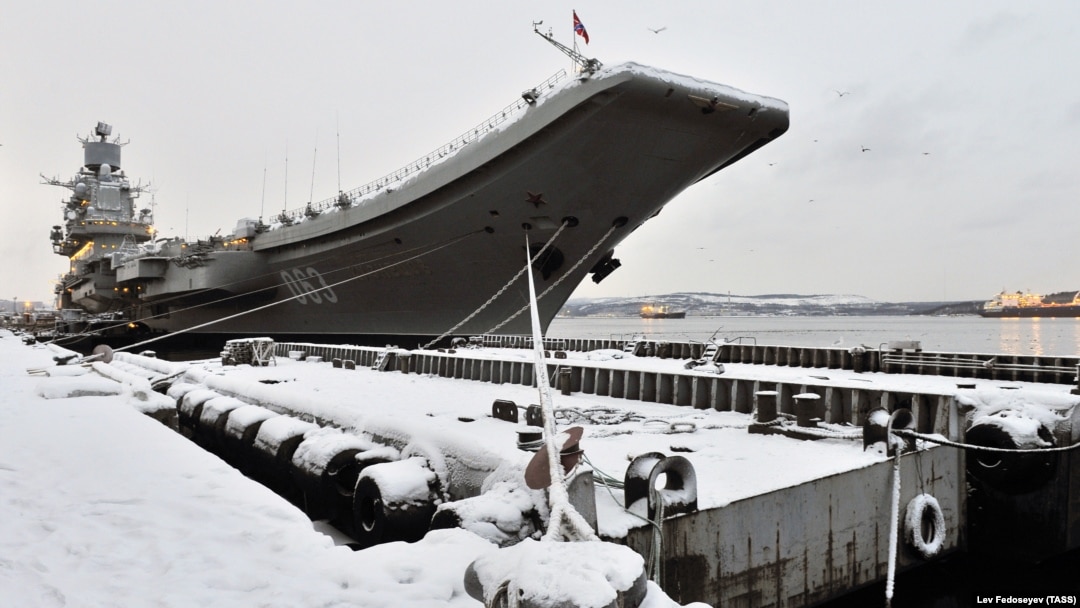It's bad enough that Russia’s only aircraft carrier was damaged in a mishap involving the country’s largest floating repair dock -- the only one big enough to maintain the flagship of the Russian Navy.
What's worse is that the decades-old dock is now sitting on the bottom of Kola Bay, not far from the major Arctic Circle city of Murmansk.
But even that may not be the extent of the bad news.
The dock, even if it is raised to the surface, may be beyond repair, meaning Russia’s only aircraft carrier, several of its largest naval ships, and at least one ballistic-missile submarine may not be able to be serviced for months, if not years.
That’s a not-insignificant setback for Kremlin efforts to upgrade the country’s fleet, experts say, an effort that parallels a larger ongoing modernization of Russia's armed forces.
“That is a very serious problem for the Russian Navy because they don’t have another thing like that,” says Pavel Felgenhauer, a longtime Russia military analyst.

The Admiral Kuznetsov in the PD-50 floating dry dock in Murmansk in 2010
Known as the PD-50 and built in Sweden in the late 1970s, the floating dock sank on October 30 as repairs were being made on the Admiral Kuznetsov, an aging 50,000-ton, Soviet-designed aircraft carrier whose frequent breakdowns and aircraft mishaps, including during recent operations over Syria, have made it an object of derision among Western observers.
In the incident, a heavy crane toppled onto the Kuznetsov, poking a hole in the ship’s deck. It was unclear what caused the incident. Some Russian press accounts suggested that the Kuznetsov might have suffered greater damage if it hadn’t pulled away from the PD-50 in time. Four workers were injured in the accident and one person remains missing and is presumed dead.
Due to its size, the dock serviced not only the Admiral Kuznetsov but other warships, like the heavy cruisers Pyotr Velikiy and Admiral Nakhimov. It was also used for repairs on the ballistic nuclear-missile submarine Dmitry Donskoi, according to Felgenhauer.
Russia has other floating docks, but they can only handle smaller ships like cruisers or cruise-missile submarines. The floating dock in the White Sea port of Severodvinsk, 800 kilometers to the southeast, is smaller but capable of hosting ballistic-missile submarines, and even the Admiral Nakhimov, though press reports said workers had great difficulty just getting the Admiral Nakhimov into the dock in the first place.
The Admiral Kuznetsov is seen in the English Channel on October 21, 2016.
Meanwhile, the closest other dock in comparable size is located in the Pacific port of Bolshoi Kamen, near Vladivostok, a 10,000-kilometer overland journey to the east -- and a vastly greater distance by sea -- a journey the Admiral Kuznetsov is in no shape to make.
“The story is likely to become infamous in the annals of Russia’s notorious shipbuilding and ship repair industry,” Michael Kofman, an analyst with the Washington-area think tank CNA, wrote in an analysis published the day after the incident.
In comments on November 7 to the TASS news agency, Aleksei Rakhmanov, the head of the state-run United Shipbuilding Corporation, said other ships had other alternatives for repairs, except for the Admiral Kuznetsov.
“We don’t feel any special problems in this regard," Rakhimov was quoted as saying.
With state coffers filled by years of high oil prices, President Vladimir Putin had sought to rebuild Russia’s military capabilities.
That effort took on greater urgency after the 2008 war with Georgia, which showcased major shortcomings in operations, tactics, and weaponry.
Another view of the Admiral Kuznetsov in the PD-50 floating dry dock in Murmansk in 2006
The Russian Navy was included in this accelerated modernization effort and was given priority in the Kremlin’s State Armament Program for 2010-20, according to a newly published report by Anton Lavrov, an independent defense analyst affiliated with the Moscow-based Center for Analysis of Strategies and Technologies.
That, he said, included construction of 24 submarines -- 16 of them nuclear -- and 54 large surface ships.
However, as of May 2018, “the ambitious plan remains largely unfulfilled,” Lavrov wrote. “There are no indications that by 2020 there will be major improvements or that the rest of planned ships will be completed. Plans for the modernization and overhaul of combat ships were also unsuccessful.”
Dmitry Gorenburg, an expert on the Russian military at Harvard University’s Davis Center, says the PD-50 accident will likely cause delays in the repairs not only of naval ships but civilian vessels, as well.
If the dock is unsalvageable, Moscow will have to have another dock of comparable size built. However, Russia doesn’t have the infrastructure to build one. Nearby Sweden, or even Norway, could, but the Western sanctions imposed in 2014 on Russia for its annexation of Ukraine’s Crimea Peninsula could prevent them from doing so.
That would leave other countries like China or South Korea, both of which have infrastructure and deep experience building massive oceangoing ships and oil-rig platforms. But even if construction on a new dock was begun immediately, it would take months if not a year or more. And then the dock would have to be towed from the Pacific, through the Indian Ocean, around Africa, through the Atlantic Ocean and Barents Sea, to Murmansk.
Another shipyard that might be capable of handling a heavy warship like the Admiral Kuznetsov is the Mykolayiv yard, where the biggest Soviet naval ships were built, located near Ukraine's Black Sea coast. But Kyiv has all but ended any defense-related trade with Moscow in the wake of the Crimean annexation and the Russian-backed war in its eastern Donbas region.
The PD-50 dry dock lies partially submerged following the October 30 incident.
For many close observers of the Russian Navy, there's wide agreement that the Admiral Kuznetsov is more of a vanity project for Russia's top brass, and that its military usefulness, even in the Syria conflict, was limited at best.
In fact, even with the State Armament Program, Russian military planners were already moving away from big oceangoing warships of the sort that made the Soviet Navy so formidable, toward smaller distance ships like frigates and corvettes, something Felgenhauer calls a “mosquito fleet.”
Outfitted with highly accurate cruise missiles known as the Kalibr, those ships have played more visible roles, particularly in the Syrian conflict, firing the missiles from the Mediterranean as well as the Caspian Sea.
But that effort has bumped up against another shortcoming in Russia's shipbuilding infrastructure, Felgenhauer says: the lack of Russian factories able to make the engines for the frigates and the corvettes.
"The Kuznetsov survives, though the carrier is largely a white elephant with no real mission besides sustaining Russia's fledgling carrier aviation, and projecting status," Kofman wrote. "Its primary mission is to exist."
"Meanwhile, the ship's track record of bringing bad luck continues unbroken," he said.


